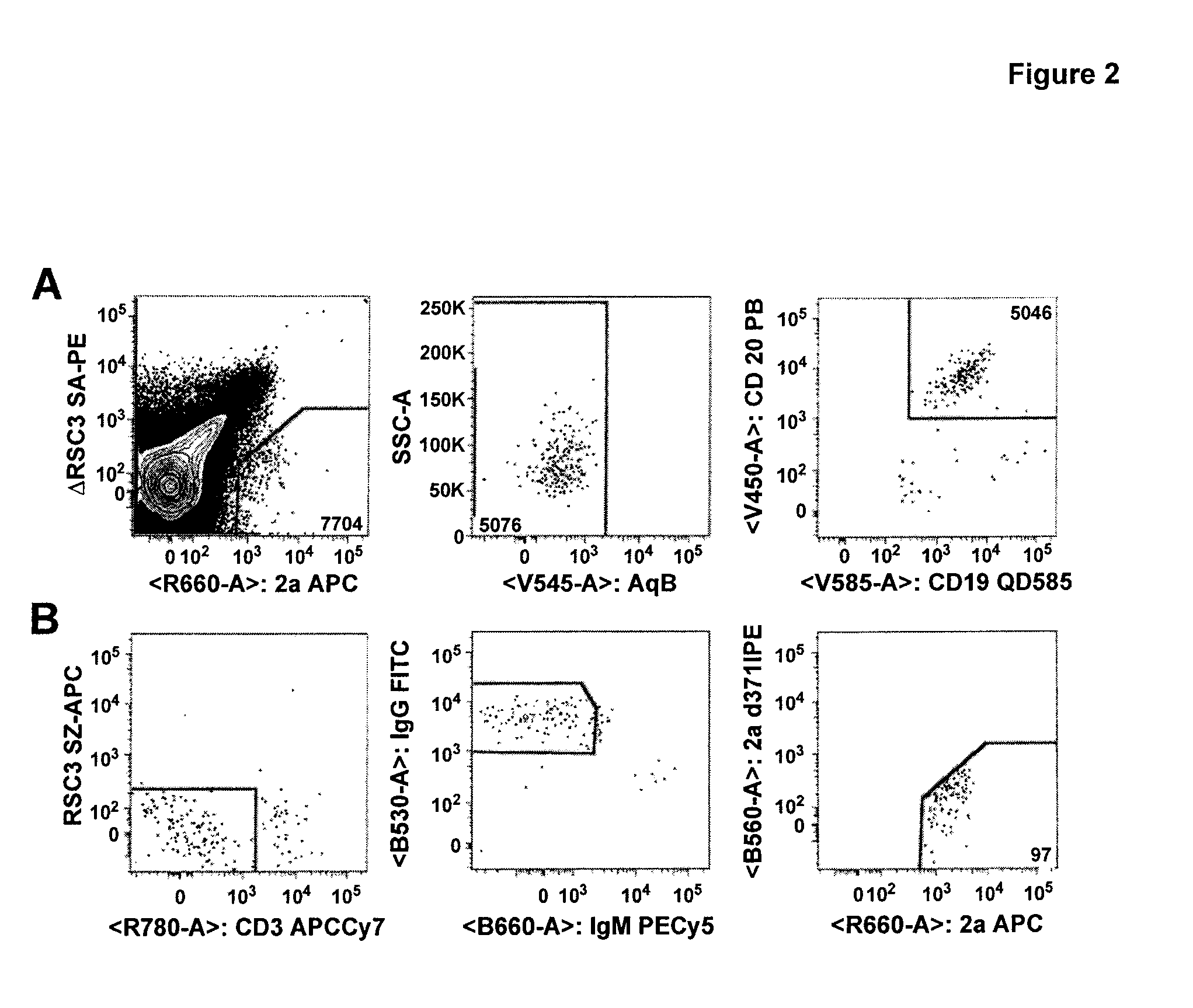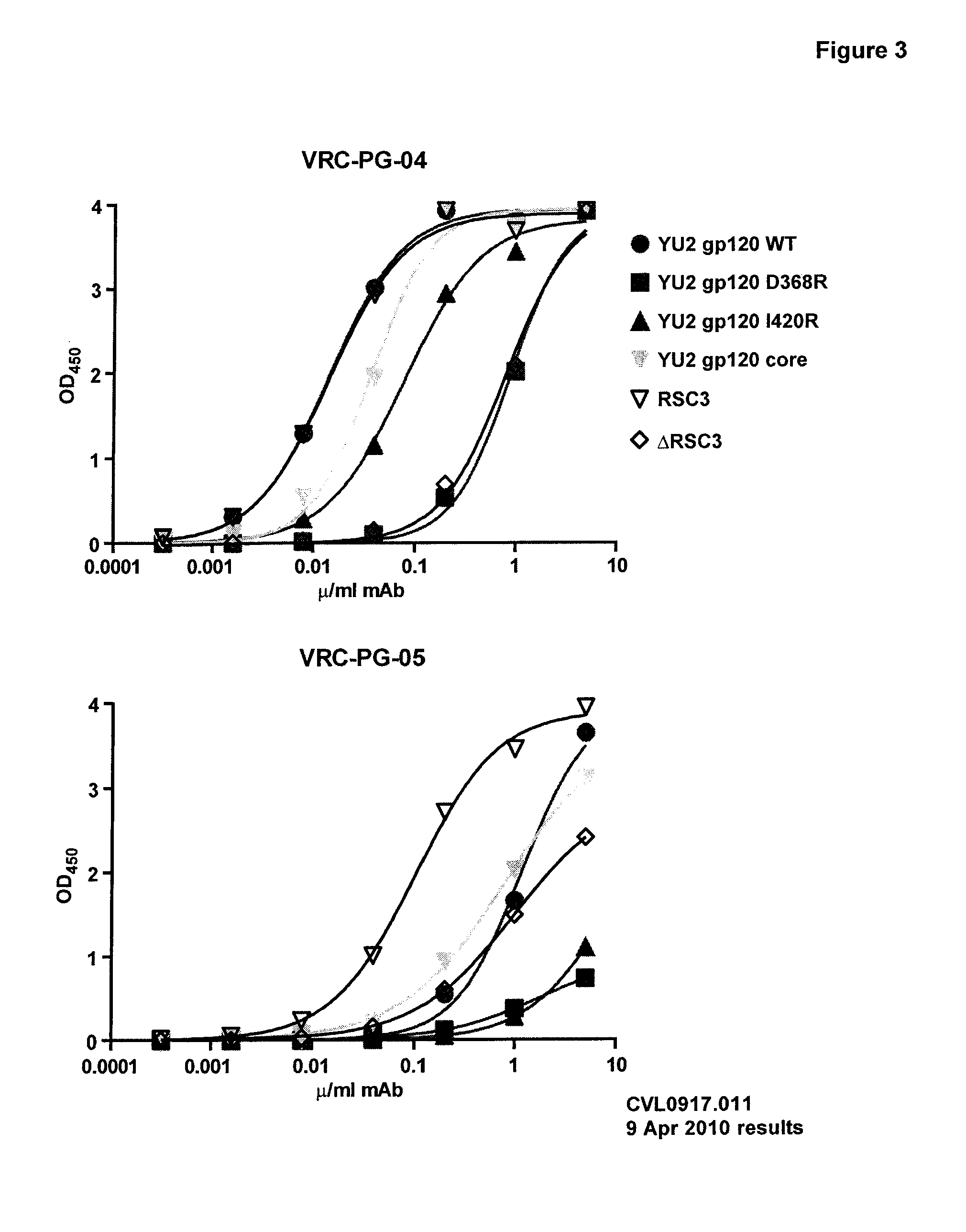Novel HIV -1 broadly neutralizing antibodies
a broad and potent technology, applied in the field of human neutralizing monoclonal antibodies, can solve the problems of serious impairment of the body's ability to fight most invaders, the ability to elicit broad and potent neutralizing antibodies, etc., and achieve the effect of reducing the effect of an infection
- Summary
- Abstract
- Description
- Claims
- Application Information
AI Technical Summary
Benefits of technology
Problems solved by technology
Method used
Image
Examples
example 1
Use of RSC3 and RSC3 Mutant Probes to Isolate Two New Neutralizing Monoclonal Antibodies from IAVI Protocol G Donor PBMC
[0130]The Protocol G serum and PBMC analysis was performed as follows. A set of 12 broadly neutralizing sera was first analyzed by resurfaces stabilized core (RSC3) ELISA for evidence of CD4 binding site (CD4bs) directed antibodies. Positive sera was further analyzed in competition neutralization assay using RSC3 to block serum neutralization. This demonstrated that sera have neutralizing antibodies (NAbs) to the CD4bs. Four out of twelve (4 / 12) sera had evidence of CD4bs directed neutralization; one was chosen for mAb isolation (VRC code was IAVI#2, corresponding to IAVI sample #27-374).
[0131]Monoclonal antibody isolation method was performed as follows. The method used was essentially the same as described in Wu et al, Science 329; 856 (2010). PBMC were incubated with RSC3 and ΔRSC3 to find B-cells reactive with RSC3 and not ΔRSC3; Single B-cells sorted into 96 w...
example 2
VRC-PG-04 Isolation
[0141]A novel monoclonal antibody, VRC-PG-04, was isolated from an HIV+ donor using an antigentically resurfaced, stabilized gp120 glycoprotein probe that was specific for the CD4 binding site. VRC-PG-04 competed with CD4-IgG for binding to gp120, demonstrating that VRC-PG-04 is directed against the CD4bs. This antibody is potent and broadly neutralizing, having a mean IC50 of 0.172 μg / ml and being able to neutralize a wide range of pseudovirus entry into TZM-bl cells, including pseudovirus from clade A—87% (n=24), B—96% (n=26), and C—79% (n=34).
[0142]To further characterize the Ab, neutralization of entry assays were carried out using a panel of JRCSF gp120 single alanine mutants incorporated into pseudovirus. Applicants found that neutralization of entry by VRC-PG-04 was knocked out (as defined by having less than 10% neutralization potency compared to wildtype) by a single mutation in aa D279 (see Neutralization Potency chart). Applicants next determined which ...
example 3
Neutralization Data of VRC-PG-04 and VRC-PG-05
[0143]Neutralization performed with Env-pseudoviruses using TZM-bl target cells. The values in Table 4 represent mAb concentration required to achieve 50% (Table 4A) or 80% (Table 4B) neutralization.
[0144]All monoclonal antibodies tested are IgG. CD4-Ig is chimeric 5 bivalent IgG-CD4 construct. VRC01, VRC02 and VRC03, b12, PG9 and PG16 were previously published and are shown for comparison.
[0145]Note: Breadth and potency calculations excluded Tier 1 viruses from clades B and C. Potency was calculated using viruses that have an IC50 or IC80 value within the tested range.
VRC-PG-VRC-PG-VRC01VRC02VRC030405b12CD4-IgPG9PG16Tier 1HXB20.0340.0420.0480.025130.0070.0051.62>50clade BMN.30.0220.0240.027>50>500.0030.006>50>50(n = 7)SF1620.1390.1120.0330.0246.840.0700.153>50>50ADA0.3790.3910.1130.1794.330.1310.0510.1280.012BaL.010.0550.05320.10.0340.2580.0930.0300.0330.993BaL.260.0480.04610.40.1480.2530.0510.0470.0190.131SS1196.10.1700.1320.0480.189>5...
PUM
| Property | Measurement | Unit |
|---|---|---|
| Therapeutic | aaaaa | aaaaa |
Abstract
Description
Claims
Application Information
 Login to View More
Login to View More - R&D
- Intellectual Property
- Life Sciences
- Materials
- Tech Scout
- Unparalleled Data Quality
- Higher Quality Content
- 60% Fewer Hallucinations
Browse by: Latest US Patents, China's latest patents, Technical Efficacy Thesaurus, Application Domain, Technology Topic, Popular Technical Reports.
© 2025 PatSnap. All rights reserved.Legal|Privacy policy|Modern Slavery Act Transparency Statement|Sitemap|About US| Contact US: help@patsnap.com



